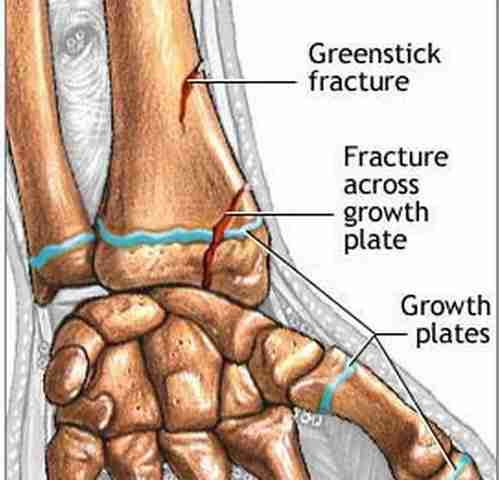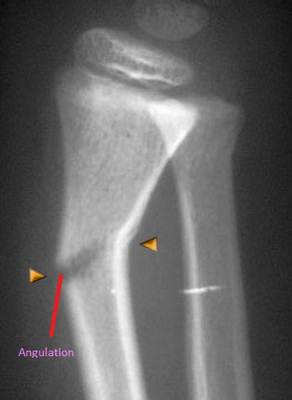Greenstick Fracture Treatment, Symptoms, Causes, Diagnosis, Pictures
What is a Greenstick Fracture?
Greenstick Fracture is defined as a type of fracture where the bone bends and partially breaks. Greenstick fracture usually occurs during infancy and childhood when bones are still soft. This fracture was discovered by John Insall, a British-American orthopedist and Michal Slupecki, a Polish-American orthopedist who described the fracture like that of a green wood, which simply breaks on the outside when bent.
The bending is known as an angulation. The swelling caused by angulation might be dorsal, which signifies it can be found at the rear of the forearm. It might also be volar, which signifies that the swelling is found at the frontside of the forearm. Commonly, there will be rotation together with the bending force, which signifies that the bone will also be rotated along the bone’s axis and not simply bend a little.
There are three basic forms of greenstick fracture, namely:
- transverse fracture
- torus or buckling fracture and
- bow fracture.
Transverse fracture occurs around the cortex that extends to the middle of the bone while torus or buckling fracture is caused by impaction, and the bow fracture occurs when the bone is curved along its longitudinal axis.
Greenstick Fracture at Wrist
These fractures are common at distal radius or distal ulna. It is like to happen in children who fell on a widely spread arm. Reduction will not be done if the dorsal angulation is mild and the reconstruction will start as the kid grows. A gradual and continuous pressure to lessen the deformity is known as reduction. It is performed until the intact dorsal cortex is fractured. If the cortex fail to break it may lead in intensifying deformity throughout the duration of the cast. The forearm is slightly turned around dorsally and a long arm cast is used for four to six weeks.
Greenstick Fracture at Radius
The bones of the forearm are radius and ulna. The fractures may occur in three sites: proximal, medial or distal end of the bone. Greenstick fracture in this area is usually shown by an incomplete break with arm displacement. Greater force may cause complete break and therefore must be given proper medical attention.

Picture of greenstick fracture of radius at wrist region
Greenstick Fracture Causes
Children are always active, they love activities such as running, playing, tumbling and skipping. Thus they always sustain injuries and most likely to experience fracture. These are the events when fractures may occur:
- Playing contact games like hide and seek
- Playing in high places
- Tripping
- Running on uneven surfaces
- Putting much weight on the limb
Usually the harmed part is the arm bones because of the tendency to guard or throw out the arms to stop oneself from falling. Such force causes the arm bone to bend and to break, but not completely. Many kids experience breaking a limb at some time in their lives and greenstick fracture is usually nothing to be concerned of, but it requires medical attention.
Greenstick Fracture Symptoms
There will be no symptoms in some cases but there would be always symptoms emerge like:
- Intense pain
- Swelling of the affected area
- Presence of abnormally bent or twisted limb
- Slight bruising on the affected area
- The child guards the affected part
- Decreased range of motion on the injured part
Diagnosis
The main factor about greenstick fractures is that it can go unnoticed and undiagnosed. A thorough medical history and physical exam is performed to confirm the diagnosis. Diagnostic tests like X-ray to reveal greenstick fractures are done to the injured and uninjured limb for comparison. In some cases were greenstick fractures are difficult to view, tests like ultrasound or computerized tomography can also be done to provide better visualization.

X-ray showing angulation/bending in Greenstick fracture
Treatment
Greenstick fractures treatment requires fracture reducing. This is done by:
- Slightly pulling the bone apart and putting it into place to straighten it. To make sure that the fracture will heal correctly, it is needed to be immobilized.
- Usually, casts are used or a removable splint for the convenience of the child. Since children’s bones tend to heal faster than those of adults, the cast or the splint maybe removed in a short span of three to four weeks.
- Physical therapy is also indicated to regain mobility and movement of the affected limb. Mostly, this type of fracture heals completely after being reduced and placed in a cast. However, if there are some instances that these measures do not take effect, surgery is advised to correct the fracture.
- When surgery is done, post operative traction may be used to straighten the hard fracture
This type of fracture is not as painful as the others, especially once the fracture has been reduced. In order to reduce swelling on the affected site, anti-inflammatory drugs can be given. Younger children may not able to express their feelings in the event greenstick fracture occurs or they can cry uncontrollably with the intensity of pain. Often they usually guard and become protective over the affected area. That is why parents are advised to have their child seek consultation when they suspect that their child sustained a major fall.
Prevention
A way to prevent greenstick fractures is
- Supervision when your child is playing and keeping him or her from harm.
- Use of car seats and seat belts are also advised.
- Ensuring of wearing a safety gear for the children when playing is also important to reduce the risk of fractures.
- The children’s diet must include adequate amount of calcium to keep bones strong and healthy.